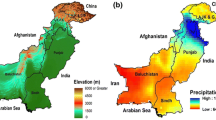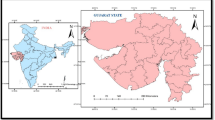Abstract
South Asia is susceptible to drought due to high variation in monthly precipitation. The drought indices deriving from remote sensing data have been used to monitor drought events. To secure agricultural land in South Asia, timely and effective drought monitoring is very important. In this study, TRMM data was utilized along with remote sensing techniques for reliable drought monitoring. The Drought Severity Index (DSI), Temperature Vegetation Drought Index (TVDI), NDVI, and Normalized Vegetation Supply Water Index (NVSWI) are more helpful in describing the drought events in South Asia due to the dryness and low vegetation. To categorize drought-affected areas, the spatial maps of TRMM were used to confirm MODIS-derived TVDI, DSI, and NVSWI. The DSI, TVDI, NVSWI, and Normalized Monthly Precipitation Anomaly Percentage (NAP) indices with an integrated use of MODIS-derived ET/PET and NDVI were selected as a tool for monitoring drought in South Asia. The seasonal DSI, TVDI, NVSWI, NAP, and NDVI values confirmed that South Asia suffered an extreme drought in 2001, which continued up to 2003. The correlation was generated among DSI, NAP, NVWSI, NDVI, TVDI, and TCI on a seasonal basis. The significantly positive correlation values of DSI, TVDI, and NVSWI were in DJF, MAM, and SON seasons, which were described as good drought monitoring indices during these seasons. During summer, the distribution values of drought indicated that more droughts occurred in the southwest regions as compared to the northeast region of South Asia. From 2001 to 2017, the change trend of drought was characterized; the difference of drought trend was obviously indicated among different regions. In South Asia, generally, the frequency of drought showed declining trends from 2001 to 2017. It was verified that these drought indices are a comprehensive drought monitoring indicator and would reduce drought risk in South Asia.












Similar content being viewed by others
References
Abbas S, Nichol JE, Qamer FM, Xu J (2014) Characterization of drought development through remote sensing: a case study in Central Yunnan, China. Remote Sens 6(6):4998–5018
Carlson TN, Gillies RR, Perry EM (1994) A method to make use of thermal infrared temperature and NDVI measurements to infer surface soil water content and fractional vegetation cover. Remote Sens Rev 9:161–173
Chen C, Zhao S (2016) Drought monitoring and analysis of Huanghuai Hai plain based on TRMM precipitation data. Remote Sens Land Resour 28(1):122–129
Chen C, Zhao S, Duan Z, Qin Z (2015) An improved spatial downscaling procedure for TRMM 3B43 precipitation product using geographically weighted regression. IEEE Journal of Selected Topics in Applied Earth Observations and Remote Sensing 8(9):4592–4604
Crow WT, Miralles DG, Cosh MH (2010) A quasi-global evaluation system for satellite based surface soil moisture retrievals. IEEE Trans Geosci Remote Sens 48(6):2516–2527
Dhorde AG, Patel NR (2016) Spatio-temporal variation in terminal drought over western India using dryness index derived from long-term MODIS data. Eco Inform 32:28–38
Duan Z, Bastiaanssen WGM, Liu J (2012) Monthly and annual validation of TRMM multisatellite precipitation analysis (TMPA) products in the Caspian Sea region for the period 1999–2003. Geoscience and Remote Sensing Symposium (IGARSS), 2012 IEEE International Geoscience and Remote Sensing Symposium:3696–3699
Hua T, Wang X, Ci Z, Lang L, Zhang C (2015) Responses of vegetation activity to climate variation on the Qinghai–Tibetan Plateau (China) from 1982 to 2011. Clim Res 66:65–73
Huang J, Xue Y, Sun S, Zhang J (2015) Spatial and temporal variability of drought during 1960–2012 in Inner Mongolia, North China. Quat Int 355:134–144
IPCC (2014) Climate Change 2014: mitigation of climate change. In: Contribution of Working Group III to the Fifth Assessment Report of the Intergovernmental Panel on Climate Change
Jackson TJ, Cosh MH, Bindlish R, Starks PJ, Bosch DD, Seyfried M, Du J (2010) Validation of advanced microwave scanning radiometer soil moisture products. IEEE Trans Geosci Remote Sens 48(12):4256–4272
Jain SK, Keshri R, Goswami A, Sarkar A, Chaudhry A (2009) Identification of drought-vulnerable areas using NOAA AVHRR data. Int J Remote Sens 30:2653–2668
Jain SK, Keshri R, Goswami A, Sarkar A (2010) Application of meteorological and vegetation indices for evaluation of drought impact: a case study for Rajasthan, India. Nat. Hazards 54 (3), 643–656.
Jung M, Reichstein M, Ciais P, Seneviratne SI, Sheffield J, Goulden ML, Bonan G, Cescatti A, Chen J, de Jeu R, Dolman AJ, Eugster W, Gerten D, Gianelle D, Gobron N, Heinke J, Kimball J, Law BE, Montagnani L, Mu Q, Mueller B, Oleson K, Papale D, Richardson AD, Roupsard O, Running S, Tomelleri E, Viovy N, Weber U, Williams C, Wood E, Zaehle S, Zhang K (2010) Recent decline in the global land evapotranspiration trend due to limited moisture supply. Nature 467:951–954
Karnieli A, Agam N, Pinker RT, Anderson M, Imhoff ML, Gutman GG, Panov N, Goldberg A (2010) Use of NDVI and land surface temperature for drought assessment: merits and limitations. J Clim 23(3):618–633
Kogan FN (1998) A typical pattern of vegetation conditions in southern Africa during El Nino years detected from AVHRR data using three-channel numerical index. Int J Remote Sens 19:3688–3694
Liu XH, Zhang JH, Xu XH (2015) Drought monitoring in Xinjiang by using MODIS-TVDI. Remote Sens Infor 30(02):111–115
Mao K, Ma Y, Xia L, Tang H, Han L (2012) The monitoring analysis for the drought in China by using an improved MPI method. J Integr Agric 11:1048–1058
McKee TB, Doesken NJ, Kleist J (1993) The relationship of drought frequency and duration to time scales. In: Proceedings of the 8th Conference on Applied Climatology, vol Vol. 17, no. 22. American Meteorological Society, Boston, pp 179–183
Mu Q, Zhao M, Kimball JS, McDowell NG, Running SW (2013) A remotely sensed global terrestrial drought severity index. Bull Am Meteorol Soc 94:83–98
Muhammad AH, Jiahua Z, Fengmei Y (2016) Drought monitoring and performance evaluation of MODIS-based drought severity index (DSI) over Pakistan. Nat Hazards 84:1349–1366
Qin Z, Tang H, Li W, Zhang H, Zhao S, Wang Q (2014) Modelling impact of agrodrought on grain production in China. Int J Disaster Risk Reduct 7:109–121
Rahimzadeh-Bajgiran P, Berg AA, Champagne C, Omasa K (2013) Estimation of soil moisture using optical/thermal infrared remote sensing in the Canadian prairies. ISPRS J Photogramm Remote Sens 83:94–103
Rouse JW, Haas RH, Schell JA, Deering DW (1973) Monitoring vegetation systems in the Great Plains with ERTS. In: Third Earth Resources Technology Satellite Symposium. NASA SP-351 I, pp 309–317
Sandholt I, Rasmussen K, Andersen J (2002) A simple interpretation of the surface temperature/vegetation index space for assessment of surface moisture status. Remote Sens Environ 79:213–224
Shao EY, Bing-Fang W (2010) Calculation of monthly precipitation anomaly percentage using web-serviced remote sensing data. Advanced computer control (ICACC), 2010 2nd international conference. vol 5. IEEE, pp 621–625
Song X, Li L, Fu G, Li J, Zhang A, Liu W, Zhang K (2014) Spatial–temporal variations of spring drought based on spring-composite index values for the Songnen plain, Northeast China. Theor Appl Climatol 116(3–4):371–384
Wan Z, Wang P, Li X (2004) Using MODIS land surface temperature and normalized difference vegetation index products for monitoring drought in the southern Great Plains, USA. Int J Remote Sens 25(1):61–72
Wang J, Price KP, Rich PM (2001) Spatial patterns of NDVI in response to precipitation and temperature in the central Great Plains. Int J Remote Sens 22(18):3827–3844
Wang H, Lin H, Liu D (2014) Remotely sensed drought index and its responses to meteorological drought in Southwest China. Remote Sens Lett 5(5):413–422
Wu J, Zhou L, Mo X, Zhou H, Zhang J, Jia R (2015) Drought monitoring and analysis in China based on the integrated surface drought index (ISDI). Int J Appl Earth Obs Geoinf 41:23–33
Xu L, Samanta A, Costa MH, Ganguly S, Nemani RR, Myneni RB (2011) Widespread decline in greenness of Amazonian vegetation due to the 2010 drought. Geophys Res Lett 38:L07402. https://doi.org/10.1029/2011GL046824
Yan H, Zhou G, Yang F, Lu X (2018) DEM correction to the TVDI method on drought monitoring in karst areas. Int J Remote Sens 1–24
Zargar A, Sadiq R, Naser B, Khan FI (2011) A review of drought indices. Environ Rev 19:333–349
Zhang SQ, Qing QT, Hou MT, Feng JD (2007) Remote sensing and impact estimation for Sichuan hot-drought based on temperature vegetation dryness index. Trans CSAE (09):141–146+294
Zhang J, Mu Q, Huang J (2016) Assessing the remotely sensed drought severity index for agricultural drought monitoring and impact analysis in North China. Ecol Indic 63:296–309
Acknowledgments
This work was supported by the Key Basic Research Project of Shandong Natural Science Foundation of China (ZR2017ZB0422), the China Postdoctoral Science Foundation Project Funding (2018M642614), and “Taishan Scholar” project of Shandong Province.
Author information
Authors and Affiliations
Corresponding authors
Ethics declarations
Conflict of interest
No conflict of interest exists in the submission of this manuscript.
Additional information
Responsible editor: Marcus Schulz
Publisher’s note
Springer Nature remains neutral with regard to jurisdictional claims in published maps and institutional affiliations.
Rights and permissions
About this article
Cite this article
Ali, S., Tong, D., Xu, Z.T. et al. Characterization of drought monitoring events through MODIS- and TRMM-based DSI and TVDI over South Asia during 2001–2017. Environ Sci Pollut Res 26, 33568–33581 (2019). https://doi.org/10.1007/s11356-019-06500-4
Received:
Accepted:
Published:
Issue Date:
DOI: https://doi.org/10.1007/s11356-019-06500-4




